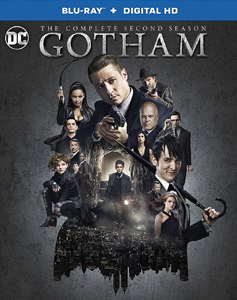A couple of milestones: My 1,000th blog post and the start of the fall TV season. This season got started with a show that’s not necessarily the best on TV, but is quickly becoming one of my favorites: “Gotham” (8 p.m. Eastern Mondays on Fox).
Whereas it was hard to brush off the unnecessarily rebooted aspects of Season 1 (Poison Ivy being called Ivy Pepper instead of Pamela Isely still rankles me), Season 2 of this prequel/reboot is starting to show more respect for the established Batman mythology.
Delving further into the characters
But rather than merely rehash too-familiar stories (like when Nolan retold the Two-Face origin story in “The Dark Knight,” halting that film’s momentum), “Gotham” is bringing to the screen aspects of the mythology previously left to the comic-book pages – and in many cases, aspects not explored in the comics to the degree one would expect.

“Gotham” Season 2 (2015)
Mondays, Fox
Creator: Bruno Heller
Stars: Ben McKenzie, Donal Logue, Cory Michael Smith
While “Gotham” has nothing to do with Nolan’s films in terms of continuity, I think those movies have influenced a lot of the TV show’s choices about which characters to focus on. Nolan’s trilogy featured the Scarecrow, Ra’s al Ghul, the Joker, Two-Face, Catwoman and Bane.
The TV show features the Penguin (the main Season 1 villain) and the Riddler (expected to be the primary Season 2 villain), along with the invented-for-“Gotham” Fish Mooney (Season 1) and Season 2’s Galavan siblings — although Tabitha Galavan is said to be “Gotham’s” answer to the obscure comics villain, the Tigress.
Meanwhile, the prototypical versions of the Scarecrow, the Joker, Two-Face and Catwoman are all in “Gotham,” but their backstories are being teased out in a different fashion than the movies, which used the approach of a single-story origin rather than long-simmering tales of how a person becomes who they become.
Jim and Bruce remain the centerpiece
The centerpiece of “Gotham” remains the relationship of Jim Gordon and Bruce Wayne. The season premiere features a scene that toes a fine line and shows respect for the definitive future relationship between Commissioner Gordon and Batman. Young Bruce suggests to Gordon that it might be OK to do something ugly (doing a favor for the Penguin) in order to make possible something good (getting back on the force so he can continue investigating the Wayne murders).
The often-understated conflict of Batman working in ugly areas and making Gordon somewhat uncomfortable (partly because of Gordon’s own actions in gray areas) is a central aspect of the Batman mythos, and this scene crisply outlines how Bruce’s and Jim’s values have always been in sync, even if they pretend otherwise.
Admittedly, “Gotham” is still doing some reimagining of the lore, but I think some leeway is allowed when adapting a comic book that dates back to 1939 and in many cases doesn’t feature “definitive” versions of the story even within that single medium. After watching the Season 2 premiere, here are the three character arcs I’m most intrigued by, and the ways they bob and weave with – but stay broadly faithful to – the comics:

Three characters to watch
Barbara Kean
In the comics, according to the Batman Wiki, she left her husband, Jim Gordon, and moved to another city. Sometimes this is connected to sociopathic behavior (of James Jr. in the comic, an interesting parallel to Barbara herself in the TV show) and sometimes to Jim cheating on Barbara with Sarah Essen (his partner in the comic, the police commish on the TV show).
In another parallel, Barbara cheating on Jim with Jim’s fellow cop, Renee Montoya, is part of why the couple – childless in the “Gotham”-verse — breaks up in Season 1. Jim has now shacked up with Morena Baccarin’s Lee. (That character is the equivalent of Dr. Leslie Thompkins of the comics; however, there she hangs out in the Waynes’ circles more so than Jim’s.)
Intriguingly played by the gorgeous Erin Richards, Barbara has had a great “Gotham” arc, starting out merely as Jim’s doting and worried fiancée, then gradually becoming unstable as their relationship destabilizes. Season 1 culminates with a bout of Stockholm Syndrome where Barbara kills her parents while under the influence of Milo Ventimiglia’s Ogre. Now she’s certifiably insane, assigned to Arkham, and in league (against her will) with the villainous Galavans.
The Joker
While it sounds ridiculous to say Batman’s arch-nemesis doesn’t have a definitive origin story in the comics, Batman Wiki says this is the case. A popular version, from “The Killing Joke,” finds the Joker (never given an actual name) as a chemical plant worker and failed stand-up comedian who consents to help in a crime in order to provide for his family, namely his wife, Jeannie.
Following a shootout, he’s gruesomely deformed into his iconic appearance. However, it seems the Joker – known for his lies and half-truths — is the Batman mythology’s answer to “The X-Files’ ” Cigarette-Smoking Man, who tells apocryphal origin stories in “Musings of a Cigarette-Smoking Man.”
On “Gotham,” the future Joker is named Jerome Valeska. In Season 1, he kills his mom, a traveling circus worker; he’s then locked up in Arkham and is now an unwitting part of the Galavan gang along with Barbara. As played by Cameron Monaghan – who has the most thankless role on TV, since the late, beloved Heath Ledger played the most recent screen version of the Joker – Jerome cackles at the end of almost every sentence. You think he’s normal one second only to be quickly reminded that he’s utterly unhinged.
Catwoman
Much like the Joker, Catwoman doesn’t have a crystal-clear origin story. The Batman Wiki says some stories find her working as a prostitute, whereas others reject that idea. She sometimes is said to have had an abusive upbringing, sometimes not. She sometimes is a flat-out thief, and sometimes only steals from criminals.
I find “Gotham’s” version of the future Catwoman — as always, named Selina Kyle, although she prefers the name “Cat” here — to be an excellent amalgam of the character’s intriguingly shady origins. In Season 1, she lives anonymously on the streets until she picks up a major positive influence – her contemporary, the teenage Bruce Wayne – to balance out her bad influences – a self-centered friend who will one day become Poison Ivy, and the general fact that she’s comfortable living the life of a petty thief.
The Season 2 premiere finds Selina working for Penguin, having transitioned from Fish Mooney’s team, which she abruptly and unconvincingly joined at the end of Season 1. While the writing of Catwoman has been a bit shaky lately, Camren Bicondova remains compelling in the role. The looks she gives to Bruce, Alfred, Detective Gordon and other potential friends suggests she’s intrigued by that world of Good, yet she’s sticking with the familiar world of Bad – for now.
She may not have a clear origin story in the comics, but Selina operating in the gray areas of Gotham – to Batman’s sometimes consternation and sometimes appreciation — has been a consistent element in most incarnations of the lore. Similarly, in all Batman yarns, we sense the history of Batman and Catwoman and how much they care about each other. In “Gotham,” we are seeing that history.

